�
METAMATERIALS
METAMATERIALS
Critique and Alternatives
BEN A. MUNK
Professor of Electrical Engineering, Emeritus
The Ohio State University
Life Fellow IEEE
A JOHN WILEY & SONS, INC., PUBLICATION
�
Copyright 2009 by John Wiley & Sons, Inc. All rights reserved.
Published by John Wiley & Sons, Inc., Hoboken, New Jersey.
Published simultaneously in Canada.
No part of this publication may be reproduced, stored in a retrieval system, or transmitted in any
form or by any means, electronic, mechanical, photocopying, recording, scanning, or otherwise,
except as permitted under Section 107 or 108 of the 1976 United States Copyright Act, without
either the prior written permission of the Publisher, or authorization through payment of the
appropriate per-copy fee to the Copyright Clearance Center, Inc., 222 Rosewood Drive, Danvers,
MA 01923, (978) 750-8400, fax (978) 750-4470, or on the web at www.copyright.com. Requests
to the Publisher for permission should be addressed to the Permissions Department, John Wiley &
Sons, Inc., 111 River Street, Hoboken, NJ 07030, (201) 748-6011, fax (201) 748-6008, or online at
http://www.wiley.com/go/permission.
Limit of Liability/Disclaimer of Warranty: While the publisher and author have used their best
efforts in preparing this book, they make no representations or warranties with respect to the
accuracy or completeness of the contents of this book and specifically disclaim any implied
warranties of merchantability or fitness for a particular purpose. No warranty may be created or
extended by sales representatives or written sales materials. The advice and strategies contained
herein may not be suitable for your situation. You should consult with a professional where
appropriate. Neither the publisher nor author shall be liable for any loss of profit or any other
commercial damages, including but not limited to special, incidental, consequential, or other
damages.
For general information on our other products and services or for technical support, please contact
our Customer Care Department within the United States at (800) 762-2974, outside the
United States at (317) 572-3993 or fax (317) 572-4002.
Wiley also publishes its books in a variety of electronic formats. Some content that appears in print
may not be available in electronic formats. For more information about Wiley products, visit our
web site at www.wiley.com.
Library of Congress Cataloging-in-Publication Data:
Munk, Ben (Benedikt A.)
Metamaterials : critique and alternatives / Ben A. Munk.
p. cm.
Includes bibliographical references and index.
ISBN 978-0-470-37704-8 (cloth)
1. Metamaterials. 2. Antennas (Electronics)–Materials. 3. Electromagnetism. 4. Radio
wave propagation–Mathematical models. 5. Antennas (Electronics)–Experiments. 6. Negative
refraction. 7. Negative refractive index. 8. Left Handed Materials. 9 Time Advance.
I. Title.
TK7871.6.M855 2008
621.3028
4—dc22
Printed in the United States of America
10 9 8 7 6 5 4 3 2 1
2008030315
�
This book is dedicated to true science.
The constant support of the ElectroScience Laboratory and my
family—in particular my wife, Aase—is deeply appreciated.
�
A NOTE ON METAMATERIALS
Metamaterials are artificially made materials that do not exist in nature.
The term derives from the Greek word meta, meaning beyond. More
specifically, metamaterials are composites that have a desired combina-
tion of properties that cannot be obtained by combining the properties of
their constituents. The term was coined in 1999 by a colleague and good
friend, Rodger Walser, of the University of Texas–Austin, now at Meta-
material, Inc. At my request he graciously provided me with the following
definition:
Metamaterials are macroscopic composites having man-made,
three-dimensional, periodic cellular architecture designed to
produce an optimized combination, not available in nature, of
two or more responses to specific excitation.
I want everybody to understand that I wholeheartedly support a devel-
opment of metamaterials in general. Only when unrealistic features, in
particular a negative index of refraction, are pursued, must I strongly
object. Academia, industry, and most urgently, students deserve an honest
and frank discussion on this subject. This book has as its focus such a
contribution.
B.A.M.
�
CONTENTS
Foreword
Preface
1 Why Periodic Structures Cannot Synthesize Negative
Indices of Refraction
xiii
xv
1
2
1
Overview 1
Background
Introduction
1.1.1
1.1.2
Current Assumptions Regarding Veselago’s Medium 2
1.2.1
1.2.2
1.2.3
Negative Index of Refraction 2
Phase Advance when n1 < 0 3
Evanescent Waves Grow with Distance for
n1 < 0 3
The Field and Phase Vectors Form a Left-Handed
Triplet for n1 < 0
1.2.4
1.1
1.2
1.3
3
Fantastic Designs Could Be Realized if Veselago’s Material
Existed 5
1.4 How Veselago’s Medium Is Envisioned To Be Synthesized
Using Periodic Structures
6
1.5 How Does a Periodic Structure Refract? 9
Infinite Arrays
1.5.1
1.5.2 What About Finite Arrays?
9
15
1.6 On the Field Surrounding an Infinite Periodic Structure
of Arbitrary Wire Elements Located in One or More
Arrays
1.6.1
1.6.2
1.6.3
16
Single Array of Elements with One Segment
Single Array of Elements with Two Segments
Single Array of Elements with an Arbitrary Number
of Segments
On Grating Lobes and Backward-Traveling Waves
20
Two Arrays of Elements with an Arbitrary Number
of Segments
1.6.4
1.6.5
16
18
19
21
vii
�
viii
CONTENTS
1.6.6
Can Arrays of Wires Ever Change the Direction
of the Incident Field?
23
1.7 On Increasing Evanescent Waves: A Fatal Misconception
1.8
23
Preliminary Conclusion: Synthesizing Veselago’s Medium
by a Periodic Structure Is Not Feasible 24
1.9 On Transmission-Line Dispersion: Backward-Traveling
Waves
1.9.1
1.9.2
26
Transmission Lines
Periodic Structures
26
30
1.10 Regarding Veselago’s Conclusion: Are There Deficiencies?
32
1.10.1 Background
1.10.2 Veselago’s Argument for a Negative Index
32
of Refraction 32
1.10.3 Veselago’s Flat Lens: Is It Really Realistic? 34
1.11 Conclusions
1.12 Common Misconceptions
35
38
1.12.1 Artificial Dielectrics: Do They Really Refract?
38
1.12.2 Real Dielectrics: How Do They Refract? 40
1.12.3 On the E- and H -Fields
1.12.4 On Concentric Split-Ring Resonators
42
1.12.5 What Would Veselago Have Asked if . . .
1.12.6 On “Magic” Structures
43
41
42
References 44
2 On Cloaks and Reactive Radomes
47
2.1
2.2
2.3
47
Concept
47
Prior Art 47
Alternative Explanation
Alternative Design 50
Cloaks
2.1.1
2.1.2
2.1.3
2.1.4
2.1.5 What Can You Really Expect from a Cloak?
Reactive Radomes
2.2.1
Infinite Planar Array with and Without Reactive
Radome
Line Arrays and Single Elements
2.2.2
Common Misconceptions
2.3.1 Misinterpretation of Calculated Results 55
51
54
51
55
48
50
�
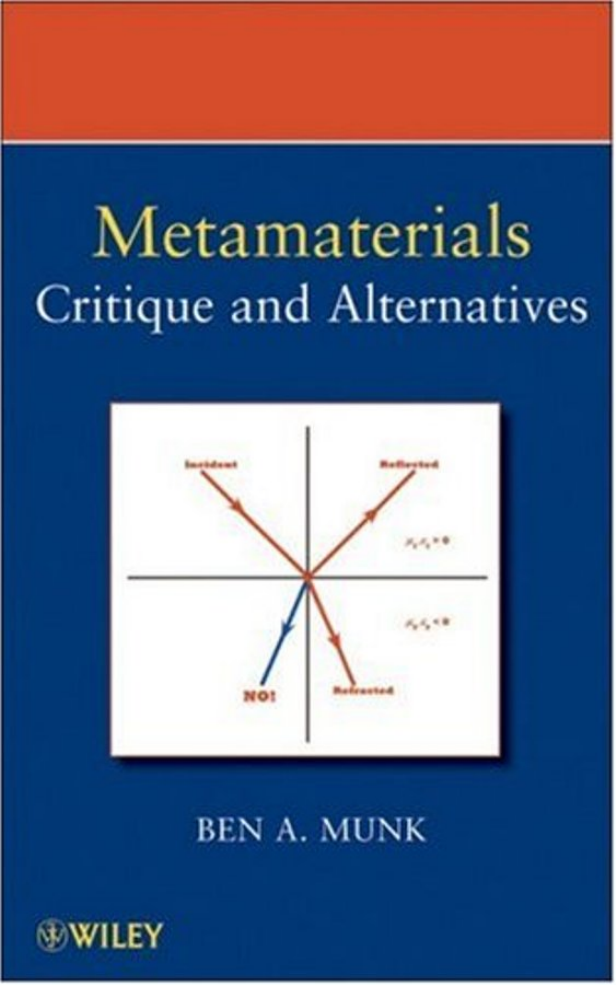
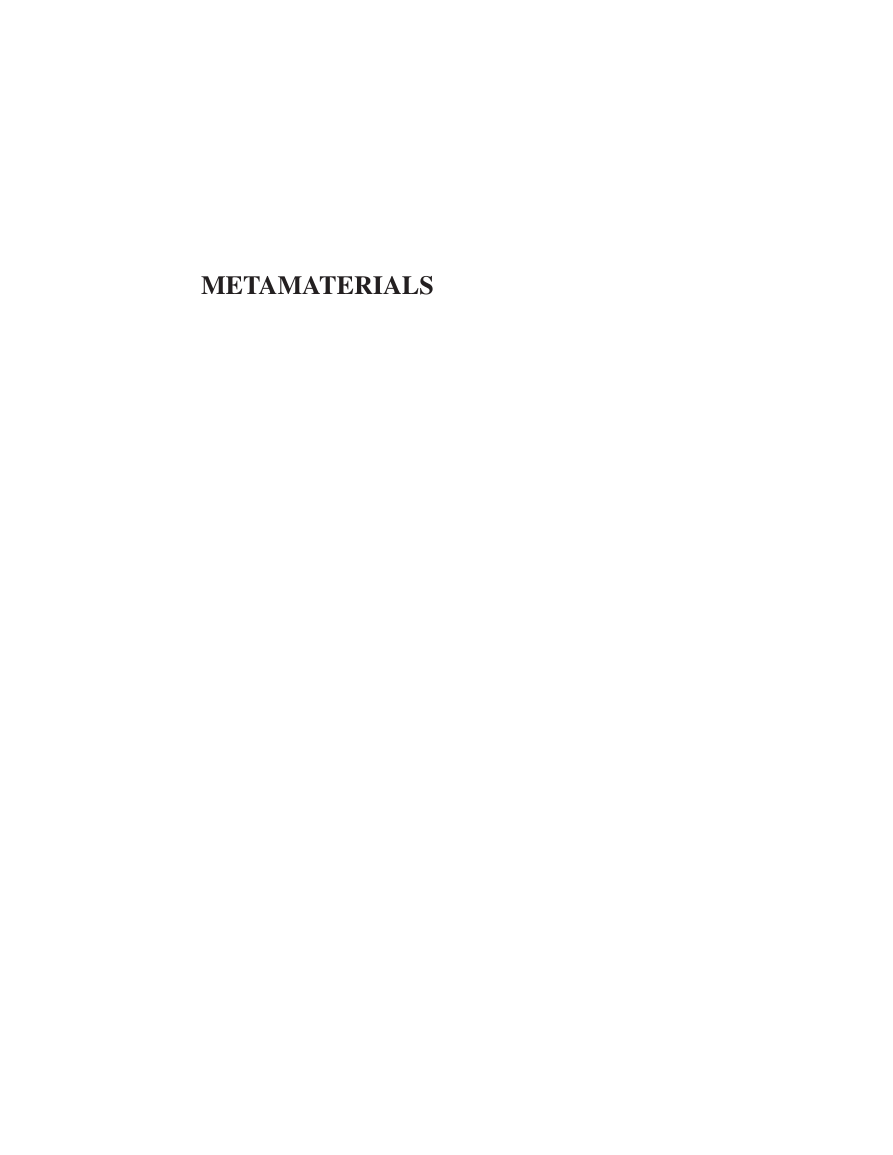
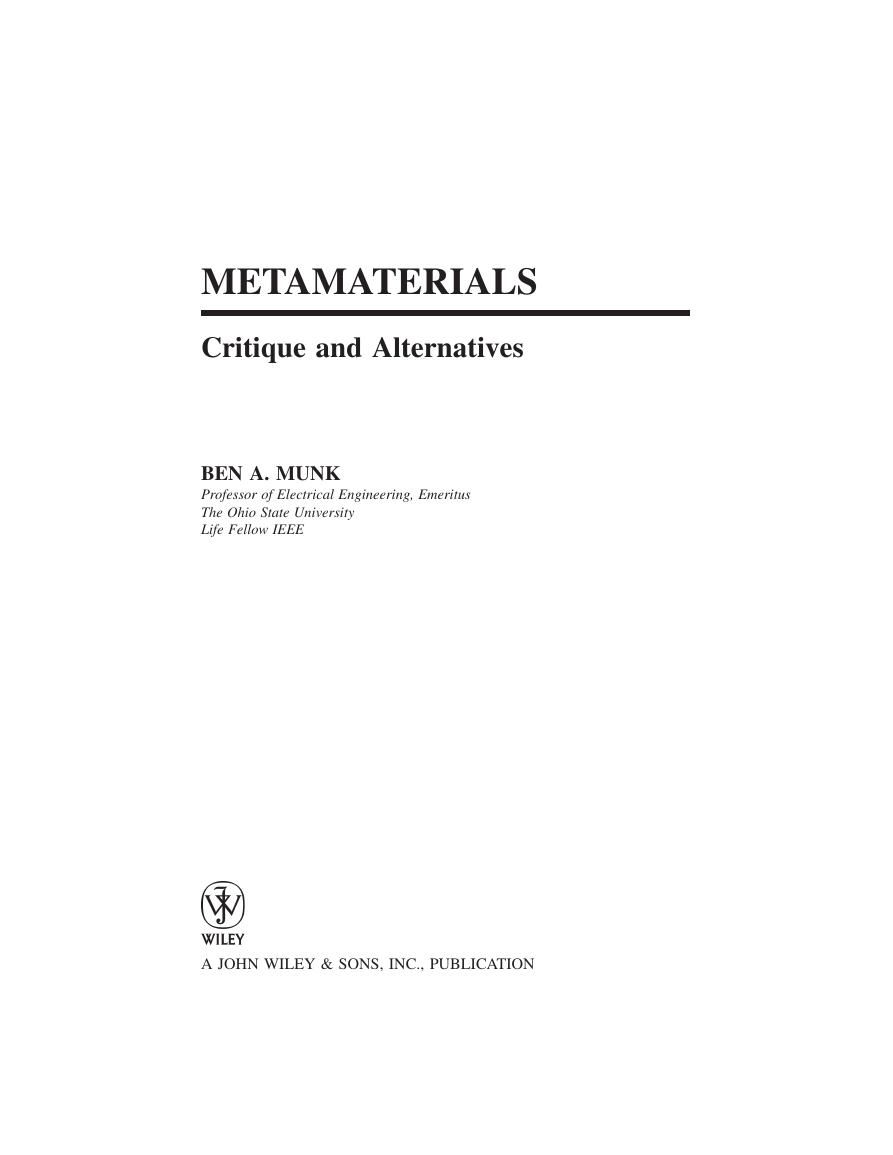
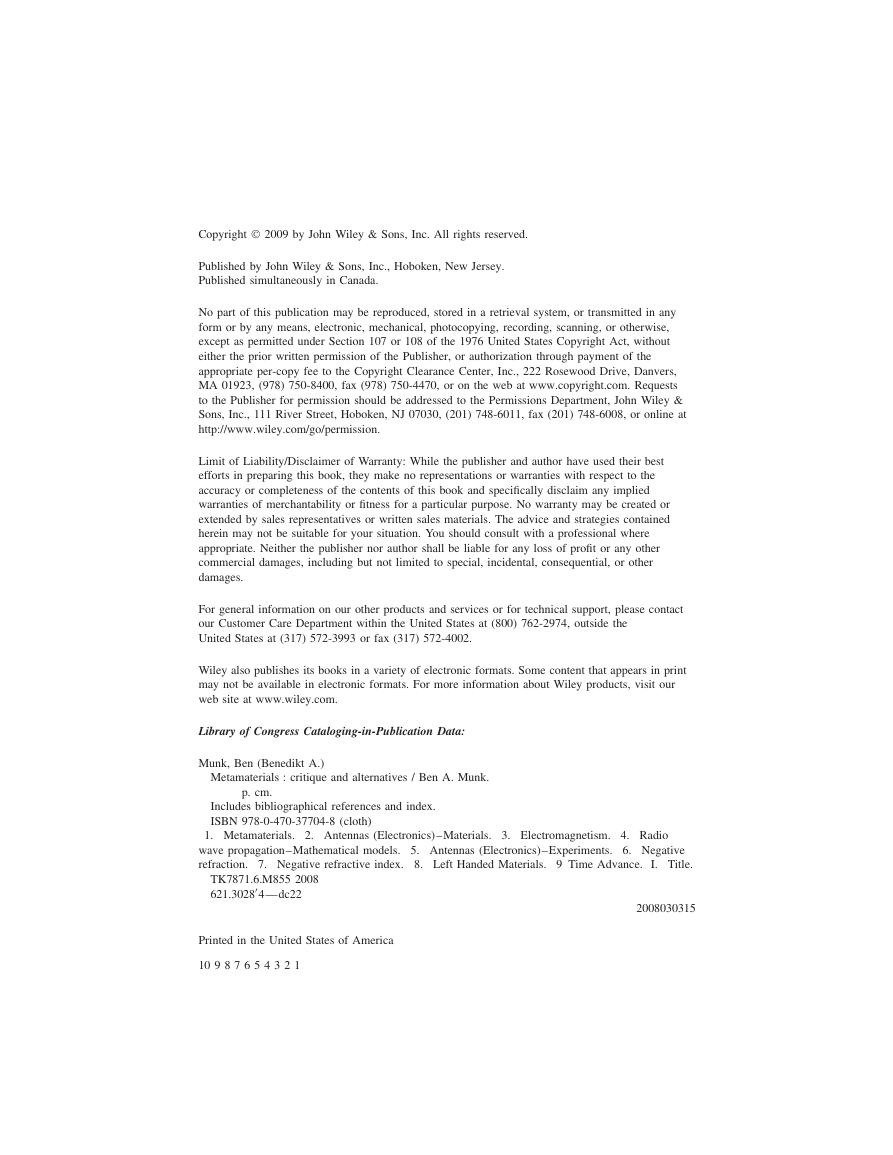
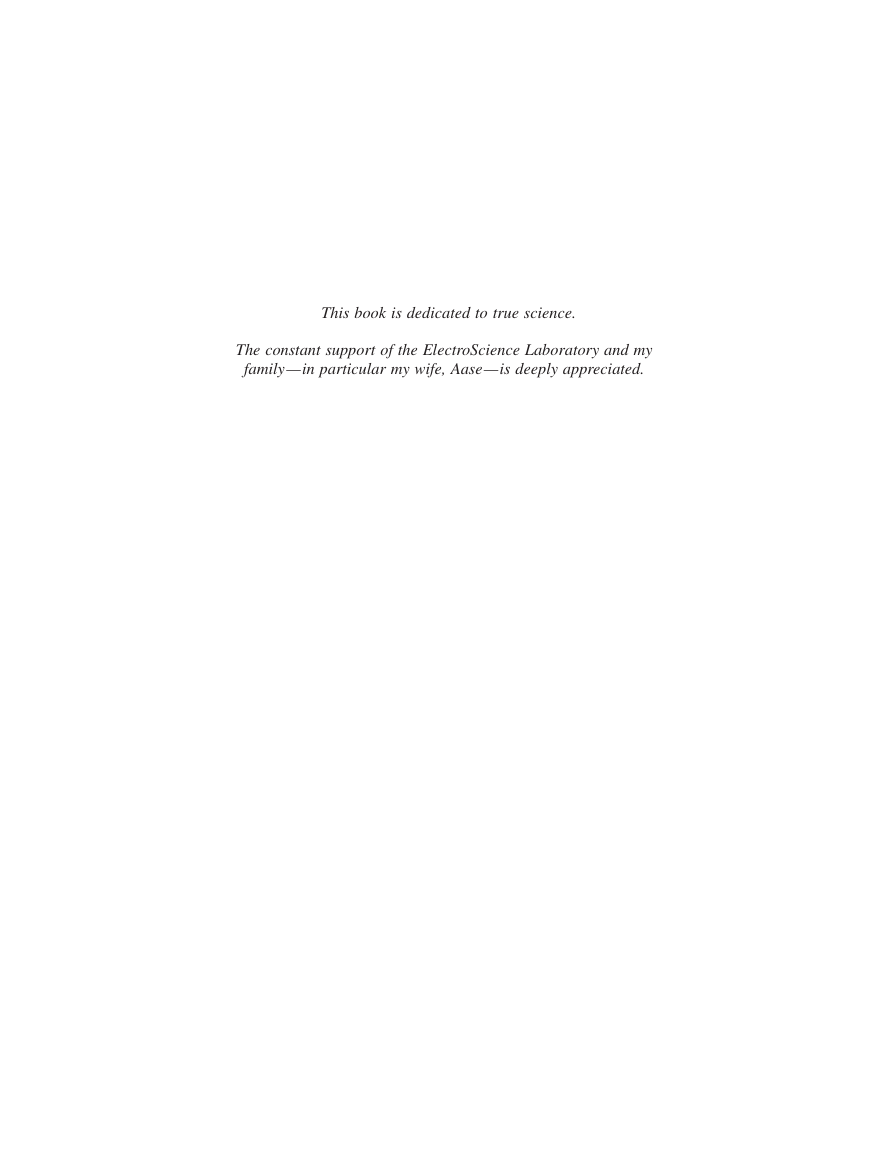
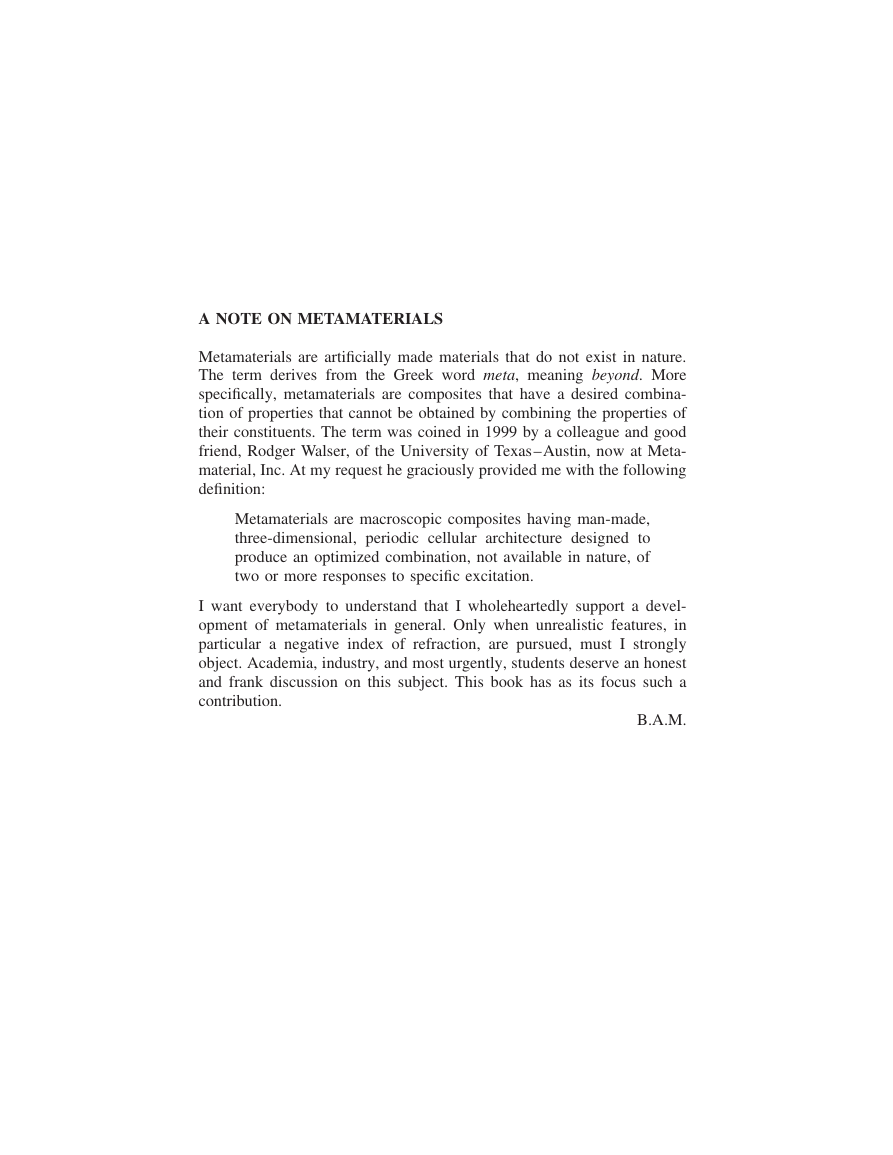
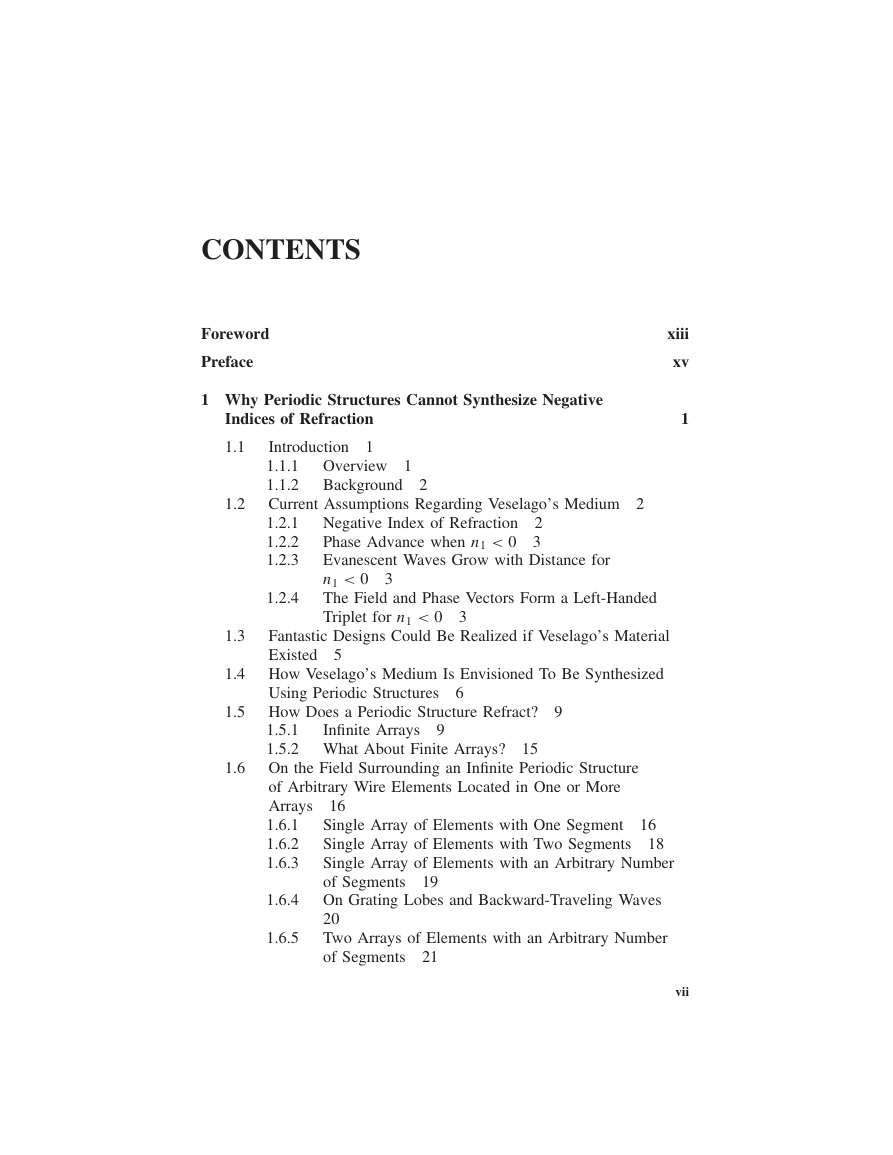
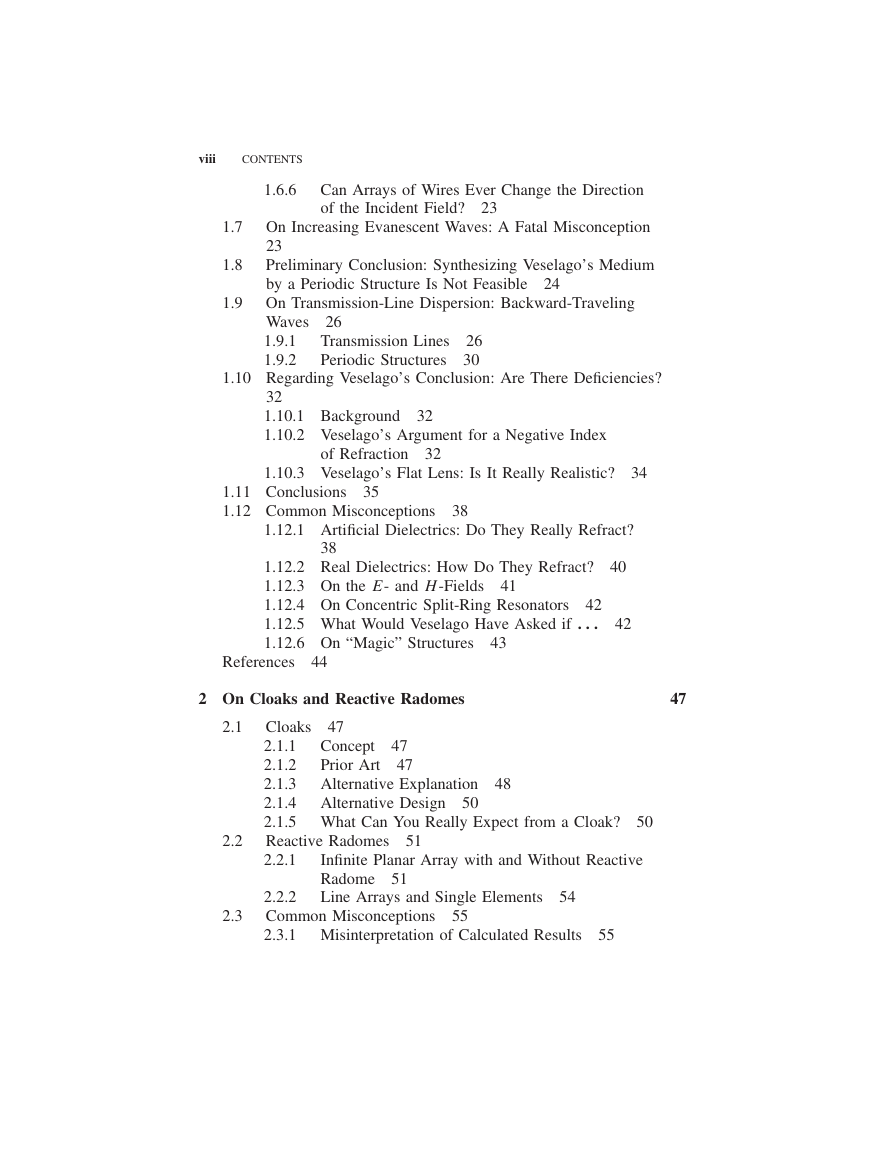








 2023年江西萍乡中考道德与法治真题及答案.doc
2023年江西萍乡中考道德与法治真题及答案.doc 2012年重庆南川中考生物真题及答案.doc
2012年重庆南川中考生物真题及答案.doc 2013年江西师范大学地理学综合及文艺理论基础考研真题.doc
2013年江西师范大学地理学综合及文艺理论基础考研真题.doc 2020年四川甘孜小升初语文真题及答案I卷.doc
2020年四川甘孜小升初语文真题及答案I卷.doc 2020年注册岩土工程师专业基础考试真题及答案.doc
2020年注册岩土工程师专业基础考试真题及答案.doc 2023-2024学年福建省厦门市九年级上学期数学月考试题及答案.doc
2023-2024学年福建省厦门市九年级上学期数学月考试题及答案.doc 2021-2022学年辽宁省沈阳市大东区九年级上学期语文期末试题及答案.doc
2021-2022学年辽宁省沈阳市大东区九年级上学期语文期末试题及答案.doc 2022-2023学年北京东城区初三第一学期物理期末试卷及答案.doc
2022-2023学年北京东城区初三第一学期物理期末试卷及答案.doc 2018上半年江西教师资格初中地理学科知识与教学能力真题及答案.doc
2018上半年江西教师资格初中地理学科知识与教学能力真题及答案.doc 2012年河北国家公务员申论考试真题及答案-省级.doc
2012年河北国家公务员申论考试真题及答案-省级.doc 2020-2021学年江苏省扬州市江都区邵樊片九年级上学期数学第一次质量检测试题及答案.doc
2020-2021学年江苏省扬州市江都区邵樊片九年级上学期数学第一次质量检测试题及答案.doc 2022下半年黑龙江教师资格证中学综合素质真题及答案.doc
2022下半年黑龙江教师资格证中学综合素质真题及答案.doc